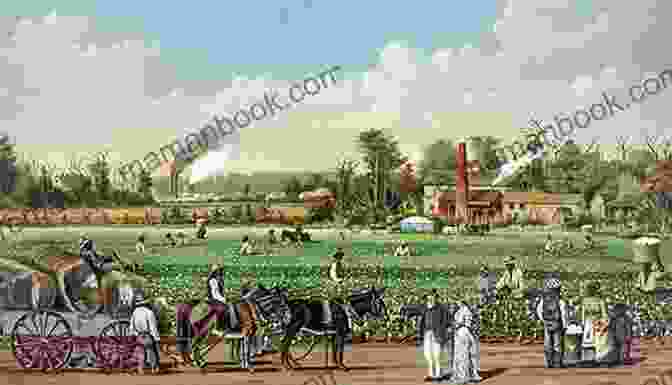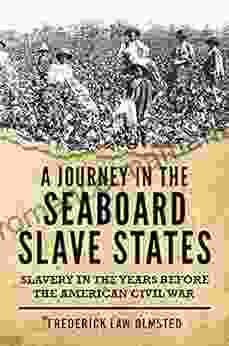Journey into the Depths of the Seaboard Slave States: A Historical Exploration

The Seaboard Slave States: A Crucible of Human Suffering and Resilience
The seaboard slave states of the United States, stretching along the Atlantic coast from Maryland to Georgia, were the heart of the antebellum South. These states were home to millions of enslaved Africans, who labored under a brutal system of oppression that shaped every aspect of their lives. Yet, despite the horrors they endured, enslaved people in the seaboard states also forged communities of resistance and resilience that would eventually help to spark the end of slavery.

4.4 out of 5
| Language | : | English |
| File size | : | 2038 KB |
| Text-to-Speech | : | Enabled |
| Screen Reader | : | Supported |
| Enhanced typesetting | : | Enabled |
| X-Ray | : | Enabled |
| Word Wise | : | Enabled |
| Print length | : | 516 pages |
The Peculiar Institution: Slavery in the Seaboard States
Slavery was the foundation of the economy and society of the seaboard slave states. Enslaved people were considered property, and they had no legal rights. They could be bought, sold, traded, and inherited like any other commodity. The vast majority of enslaved people in the seaboard states worked on plantations, where they were forced to labor in the fields from sunrise to sunset.
Slaveowners used a variety of methods to control their enslaved workforce. They employed overseers to supervise the slaves' work and to punish them for any infraction, no matter how minor. They also used physical violence, whippings, and other forms of torture to keep their slaves in line.
The conditions under which enslaved people lived were often horrific. They were housed in cramped and unsanitary quarters, and they were often denied adequate food, clothing, and medical care. Many enslaved people died from disease, malnutrition, or injuries sustained while working in the fields.
Resistance and Resilience: The Fight for Freedom
Despite the oppressive conditions they faced, enslaved people in the seaboard states never gave up hope of freedom. They resisted slavery in a variety of ways, both large and small. Some enslaved people ran away from their plantations, while others organized revolts and insurrections. Still others engaged in acts of sabotage, such as slowing down their work or damaging their masters' property.
One of the most famous slave revolts in the seaboard states was the Stono Rebellion, which occurred in South Carolina in 1739. Led by a man named Jemmy, a group of enslaved Africans killed their overseers and marched on the town of Stono. The rebellion was eventually put down by the militia, but it showed that enslaved people were willing to fight for their freedom, no matter how great the odds.
Another form of resistance that was common among enslaved people in the seaboard states was the creation of independent black churches. These churches were places where enslaved people could gather together, worship, and discuss their experiences. They also served as centers of resistance, where enslaved people could plan and organize their fight for freedom.
The efforts of enslaved people to resist slavery ultimately helped to bring about the end of the institution. The Civil War, which began in 1861, was fought over the issue of slavery, and it led to the emancipation of all enslaved people in the United States.
The Legacy of Slavery in the Seaboard States
The legacy of slavery in the seaboard slave states is still felt today. The region is home to a large population of African Americans, and many of them are descendants of enslaved people. The legacy of slavery can be seen in the region's high rates of poverty, crime, and unemployment. It can also be seen in the ongoing struggle for racial equality.
However, the legacy of slavery is not only one of oppression and suffering. It is also a legacy of resistance and resilience. Enslaved people in the seaboard states fought for their freedom, and they ultimately helped to bring about the end of slavery. Their story is a testament to the human spirit's ability to overcome even the most oppressive conditions.
The seaboard slave states were a crucible of human suffering and resilience. Enslaved people in these states endured unimaginable horrors, but they never gave up hope of freedom. Their resistance and resilience ultimately helped to bring about the end of slavery, and their legacy continues to inspire people today.
4.4 out of 5
| Language | : | English |
| File size | : | 2038 KB |
| Text-to-Speech | : | Enabled |
| Screen Reader | : | Supported |
| Enhanced typesetting | : | Enabled |
| X-Ray | : | Enabled |
| Word Wise | : | Enabled |
| Print length | : | 516 pages |
Do you want to contribute by writing guest posts on this blog?
Please contact us and send us a resume of previous articles that you have written.
 Top Book
Top Book Novel
Novel Fiction
Fiction Nonfiction
Nonfiction Literature
Literature Paperback
Paperback Hardcover
Hardcover E-book
E-book Audiobook
Audiobook Bestseller
Bestseller Classic
Classic Mystery
Mystery Thriller
Thriller Romance
Romance Fantasy
Fantasy Science Fiction
Science Fiction Biography
Biography Memoir
Memoir Autobiography
Autobiography Poetry
Poetry Drama
Drama Historical Fiction
Historical Fiction Self-help
Self-help Young Adult
Young Adult Childrens Books
Childrens Books Graphic Novel
Graphic Novel Anthology
Anthology Series
Series Encyclopedia
Encyclopedia Reference
Reference Guidebook
Guidebook Textbook
Textbook Workbook
Workbook Journal
Journal Diary
Diary Manuscript
Manuscript Folio
Folio Pulp Fiction
Pulp Fiction Short Stories
Short Stories Fairy Tales
Fairy Tales Fables
Fables Mythology
Mythology Philosophy
Philosophy Religion
Religion Spirituality
Spirituality Essays
Essays Critique
Critique Commentary
Commentary Glossary
Glossary Bibliography
Bibliography Index
Index Table of Contents
Table of Contents Preface
Preface Introduction
Introduction Foreword
Foreword Afterword
Afterword Appendices
Appendices Annotations
Annotations Footnotes
Footnotes Epilogue
Epilogue Prologue
Prologue Kenneth Steven
Kenneth Steven Nancy Krulik
Nancy Krulik Sam Ferguson
Sam Ferguson Terry Sullivan
Terry Sullivan Dr David Klein
Dr David Klein Kay P Dawson
Kay P Dawson Paola Subacchi
Paola Subacchi Kj Kalis
Kj Kalis Cee Bowerman
Cee Bowerman Clinton L Jeffery
Clinton L Jeffery L L Parker
L L Parker Hollee Temple
Hollee Temple Stephen Robles
Stephen Robles David Whyte
David Whyte Brian C Mitchell
Brian C Mitchell Margaret Gurevich
Margaret Gurevich Natalie Dean
Natalie Dean Tiffany Carby
Tiffany Carby Roy Thomas
Roy Thomas Heather Grace Stewart
Heather Grace Stewart
Light bulbAdvertise smarter! Our strategic ad space ensures maximum exposure. Reserve your spot today!
 Joseph ConradFollow ·2.7k
Joseph ConradFollow ·2.7k Forrest BlairFollow ·4k
Forrest BlairFollow ·4k Gus HayesFollow ·17.5k
Gus HayesFollow ·17.5k Herman MitchellFollow ·15.9k
Herman MitchellFollow ·15.9k Javier BellFollow ·14.6k
Javier BellFollow ·14.6k Bob CooperFollow ·3.3k
Bob CooperFollow ·3.3k Kenneth ParkerFollow ·10.7k
Kenneth ParkerFollow ·10.7k D'Angelo CarterFollow ·7.6k
D'Angelo CarterFollow ·7.6k

 Jared Nelson
Jared NelsonThe Da Vinci Code: A Literary Odyssey into the World of...
A captivating image of The Da Vinci Code...

 Harvey Bell
Harvey BellJohn Pearce: An Action-Packed Maritime Adventure
Join John...

 Ken Follett
Ken FollettSky Dragons: Unveiling the Majestic Creatures from the...
In the ethereal world of Anne McCaffrey's...

 Blake Bell
Blake BellEasy And Delicious Baking Recipes You Can Effortlessly...
Baking can be a great way to relax and...

 Maurice Parker
Maurice ParkerUnveiling the Profound Insights and Lyrical Beauty of...
In the realm of contemporary poetry, "Growl...
4.4 out of 5
| Language | : | English |
| File size | : | 2038 KB |
| Text-to-Speech | : | Enabled |
| Screen Reader | : | Supported |
| Enhanced typesetting | : | Enabled |
| X-Ray | : | Enabled |
| Word Wise | : | Enabled |
| Print length | : | 516 pages |














